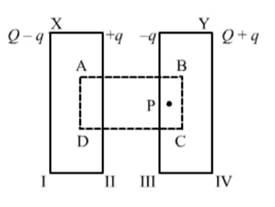The plates of a parallel-plate capacitor are given equal positive charges. What will be the potential difference between the plates? What will be the charges on the facing surfaces and on the outer surfaces?
Given:
Two plates of a parallel plate capacitor with equal charge.
Here, both the plates are given same charge +Q.

Consider q charge on face II so that induced charge on face III is -q
Assume a rectangular Gaussian surface ABCD having area, A as shown in the above fig.
Thus, Electric field at point P due to face I E1=![]()
Electric field at point P due to face II E2=![]()
Electric field at point P due to face III E3=![]()
Electric field at point P due to face IV E4= ![]()
negative sign because electric field due to face IV is in leftwards direction).
Since , point P lies inside the conductor thee total electric field at P must be zero
∴ E1+E2+E3+E4=0
⇒![]() =0
=0
∴ q=0
Therefore zero charge appears on face II and III and Q charge appears on face I and IV
Potential difference b/w the plates is given by
![]()
∴ V=0 both the plates are at same potential since both are given equal charges)
1)Potential difference between the plates=0.
2)Charges on outer faces of plates=+Q.
3)Charges on inner faces of plates=0.